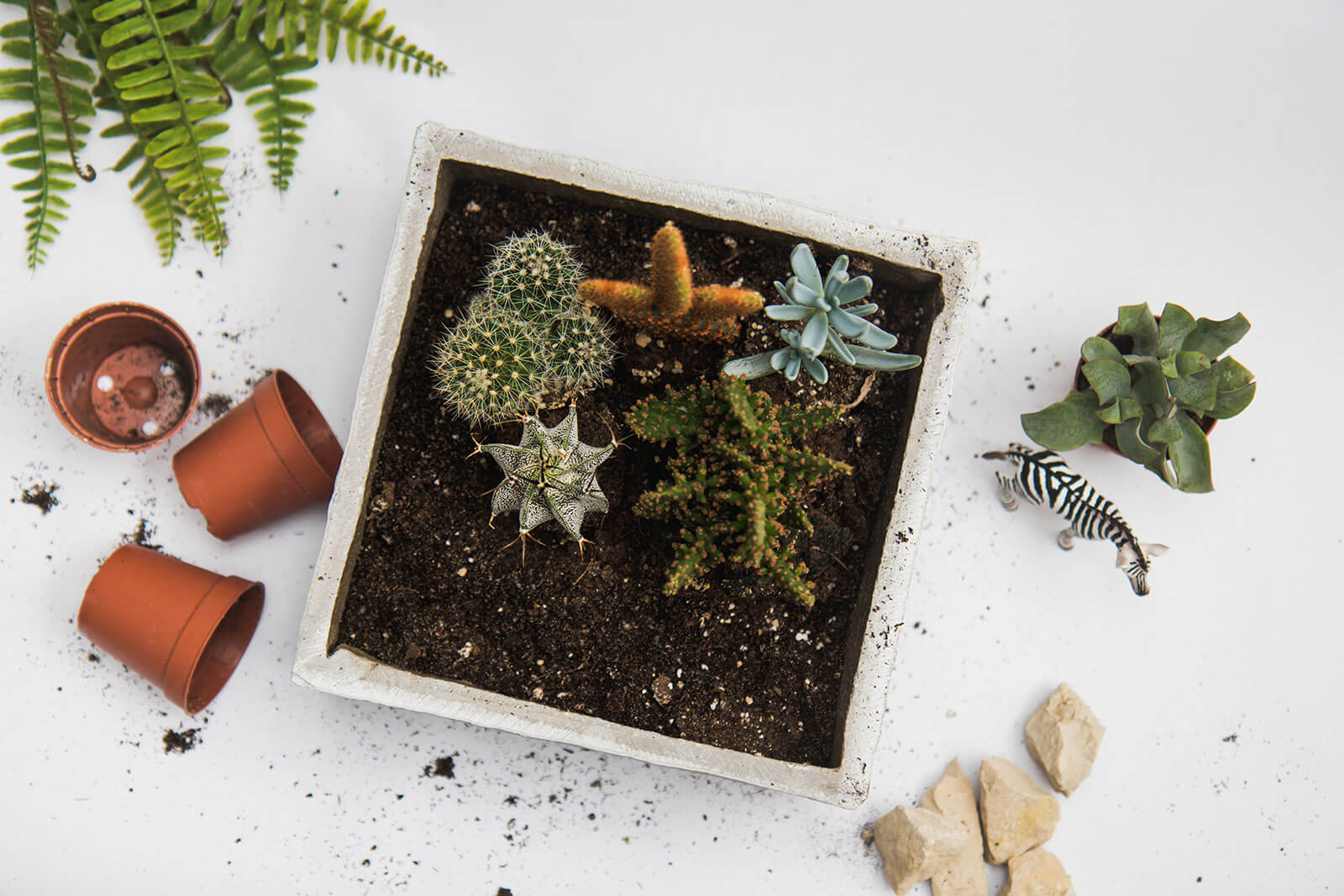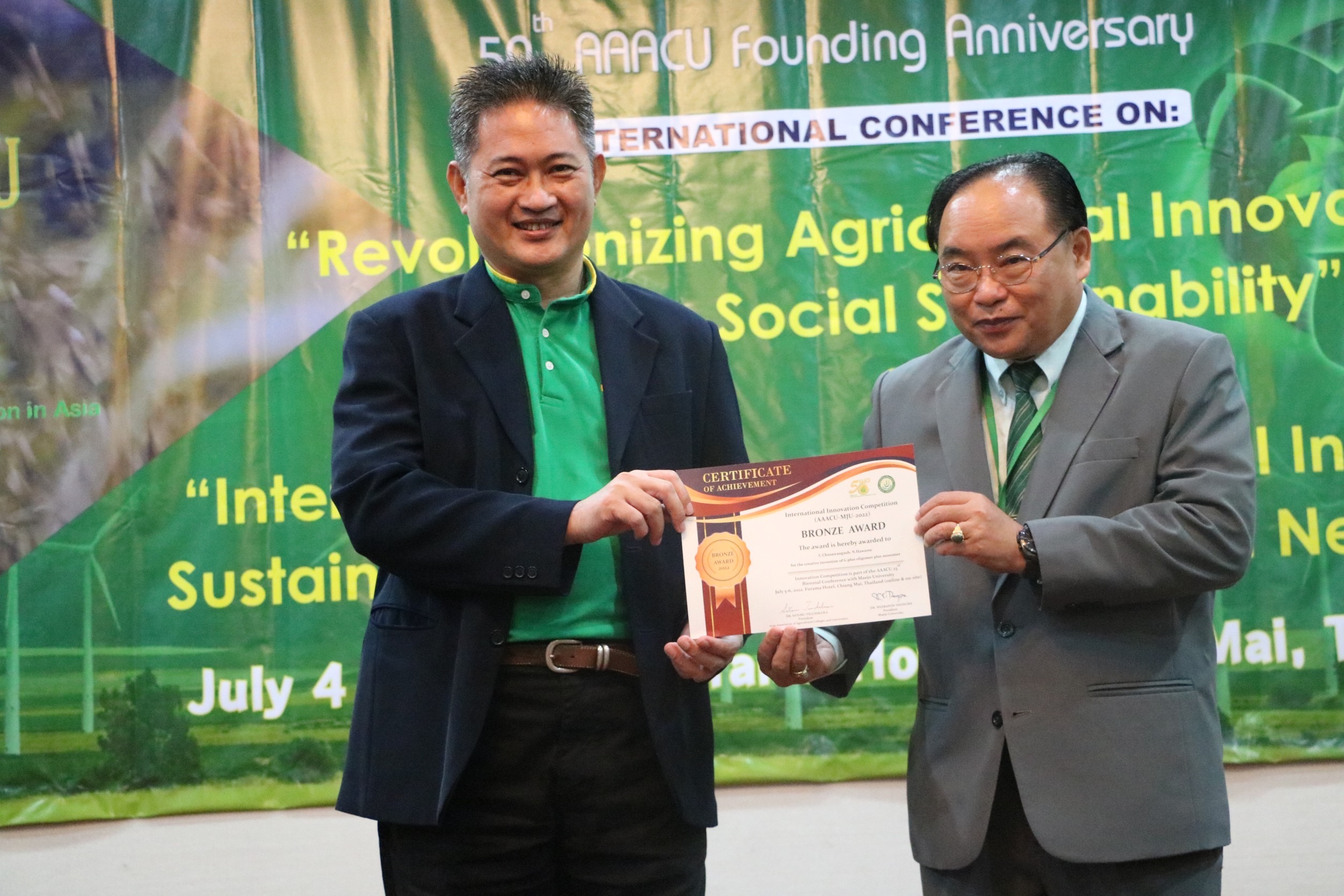Citrus is a genus of flowering trees and shrubs in the rue family, Rutaceae includes essential crops like oranges, lemons, grapefruit, and limes. Hundreds of species are expanding all over the world. Most of them have a pungent odor and contain essential oils in their foliage, blossoms, and fruits. Citrus trees in Thailand are divided into four categories, as shown below (Citrus, Wikipedia).
- The orange group is divided into Sweet Oranges (Citrus sinensis) and Sour or Bitter Orange (Citrus aurantium).
- Mandarin group including Satsuma Mandarin (Citrus unshiu), King Mandarin (Citrus nobilis), Mediterranean Mandarin (Citrus delicoia), and Common Mandarin (Citrus reticulata).
- Pummelo and Grapefruits group including Pummelo (Citrus maxima) and Grapefruits (Citrus paradise).
- Common acid member groups include Citron (Citrus medica) and Citrus lemon.
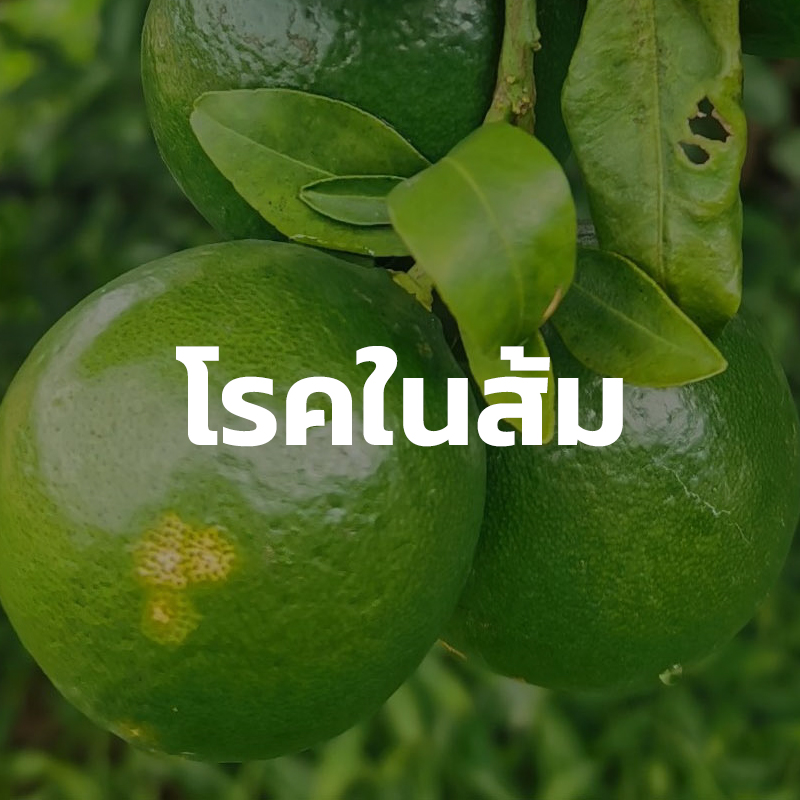
There are common citrus species grown in Thailand include Sweet Orange (C. sinensis), Tangerine (C. reticulata), Neck Orange (C. nobilis), Acidless Orange (C. sinensis), and Pummelo (C. grandis or C. maxima).
Citrus is a helpful fruit with a high nutrient content that is widely consumed. There are both local sales and exports to other countries. The most popular in the market is Tangerine. They rank among Thailand’s major export crops roughly 128,046 rai are under cultivation, mostly in the north 95.3 percent were accountable. Citrus worth 1,138.26 million Baht were exported in 2021, totaling 47,318.94 tons. (Office of Agriculture Economics, 2021)
Citrus farmers frequently face the issue of greening disease, which is a disease that causes significant problems in citrus, resulting in lower output, no flavor, distorted fruit shape, and market unacceptability. Greening is a significant disease in citrus crops, especially mandarin and sweet orange, as well as pomelo (Citrus maxima) and small acid lime (Citrus aurantifolia). It causes citrus plant harm from the past to the present. (Jaikuankaew et al., 2016)
Citrus Greening Disease (CGD), also known as Huanglongbing (HLB), is important in citrus farming because of its severe damage, decreased yield, poor quality, and frequent disappearance before harvest. Candidatus Liberibacter species of bacteria are primarily accountable for the disease and cannot be grown on a culture medium (Poonyapitak et al., 2016; Jantasorn et al., 2007). These bacteria are limited to the phloem of the host plant and are found in low densities when living in the sieve tube of the host plant. Proteobacteria are alpha subgroups of bacteria that include two proteobacteria species, Candidatus Liberibacter asiaticus, and Candidatus Liberibacter africanus, that have peptidoglycan-like cell walls of gram-negative bacteria. (Jatasorn et al., 2007)
The symptoms discovered on the leaves will have two distinct characteristics: the first variety will have yellow symptoms with obvious green veins. On elder leaves, veins, and pulp may be more translucent than normal (vein clearing). Yellowing and blotchy mottling are frequently observed. The branches quickly dry out and perish. The end of the branch has a sign of mortality. Characteristic 2: The leaves are smaller, slenderer, longer, and thicker than normal. The vein is green, while the leaf area is yellow, this symptom is like signs of zinc deficiency. The blades tend to point upward. The characteristic signs of this disease used in observation are blotchy mottling patterns on leaves (Figure 2.5). (Tipu et al., 2021; Jantasorn et al., 2007)
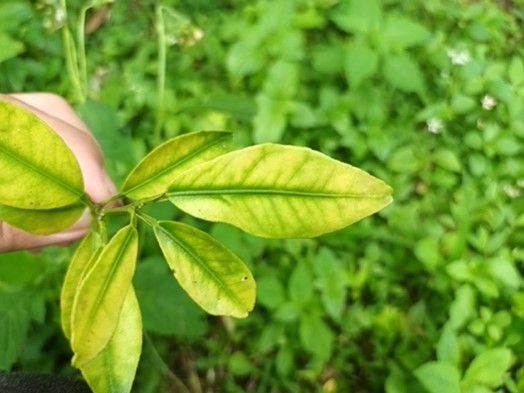
One of the primary vectors for transmitting the disease by feeding on citrus leaves is the Asian Citrus Psyllid (ACP) or Diaphorina citri Kuawayama the insect in the family Psyllidae (Figure 2.6). ACP larvae and adults harm citrus trees by living on and sucking from the buds and new shoots. The larva secretes a white thread-like material like nectar, which causes black mold to grow. Furthermore, it will emit toxins, causing the tips to wither and the foliage to curl. If a serious injury causes the foliage to fall, the fruit is smaller or does not fruit at all. In the situation of greening disease, it functions as a vector for the infection to spread to other citrus trees. It can carry a bacterium for many days and can transmit to an uninfected plant when feeding on it. The phloem tissues of the roots and leaves are severely obstructed because of bacterial migration inside these two parts of the plant. As a result, obstruction to the circulation of nutrients and sugars in the interior tissues leads to leaf loss, uneven fruit size, which can impair the flavor and texture of fruits, premature fruit drop, and eventually the death of the tree. (Poonyapitak et al., 2016; Bendix and Lewis, 2018; Food Agriculture Organization of the United Nation [FAO]; Jantasorn et al., 2007; Tipu et al., 2021)
The excessive accumulation of starch in the remaining parenchyma cells of the aerial parts and photosynthetic cells is one of the most obvious symptoms of CGD in citrus trees. These can be detected by an iodine test. By observing how the leaves change color, one can tell whether a citrus tree is infected with the CGD by determining if the leaves turn blue or purple (positive test). If not, the leaves are healthy. (Whitaker et al., 2014)
Currently, there are no efficient methods or recommendations for controlling or managing Citrus Greening Disease. Academic articles frequently advise farmers to use pathogen-free seedlings or cultivar stems and to manage the insect vector Asian Citrus Psyllid. However, in farmers’ growth circumstances, it has been discovered that pathogen-free citrus trees typically begin to exhibit signs of greening disease 1-2 years after planting, and because there are no concrete measures to manage the disease, bug vectors cannot be effectively controlled. Because the causative pathogen of the disease only lives in the plant’s phloem cells, the injection of medicines such as ampicillin into the trunk is a common method for preventing or curing the disease. (Jaikuankaew et al., 2016; Stephano-Honedo et al., 2020).
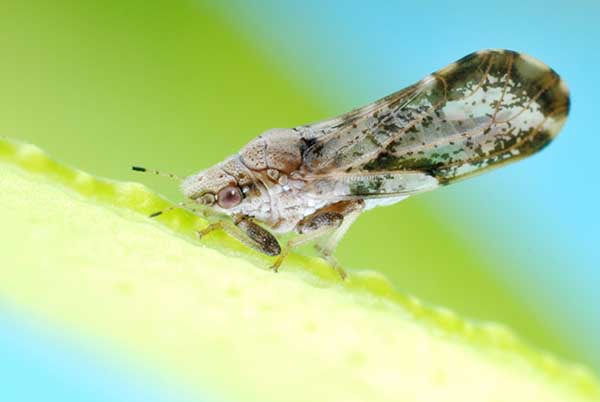
or Diaphorina citri Kuawayama
(Source: https://www.kasetsanjorn.com/2172/)
The use of antibiotics in field crops is, undoubtedly, constrained by the emergence of microbial resistance, which also poses a significant risk to human health due to its indirect effects (Stephano-Honedo et al., 2020.) The research from the Faculty of Pharmacy, Chiang Mai University, Thailand, found the accumulation of antibiotics in citrus fruit and remains for up to 90 days. They are seriously concerned about the citrus orchard’s ecology, where antibiotic residues have begun to accumulate in the water, soil, and citrus plants. These might impact the food chain and result in bacterial resistance that can be transmitted to humans. In actuality, the disease cannot currently be treated with chemicals or any other types of controls. Therefore, it is obvious that a long-term cure for CGD infection in plants is required immediately (Jaikuankaew et al., 2016; Stephano-Honedo et al., 2020)
Citrus Greening Disease (CGD) testing
Diagnosis criteria for showing symptoms of CGD consider the splotchy mottling of the entire leaf as shown in Figure 3.4.

show the splotchy mottling of entire leaves.
Use an iodine test kit to determine whether citrus trees were infected by the greening disease.
- Crush the citrus leaves (3 g) with distilled water (3 ml) in the mortar. Then filter the crushed solution and put it in a transparent sachet.
- Dip the iodine litmus paper into the sachet, left it for 1 minute, and then observe the color change.
- Use a dropper to drop iodine solution into the sachet, left it for 1 minute, and then observe the color change.
- The observed color of the solution in a sachet will turn blue or purple color meaning a positive result or infected tree detection while no color change means no infection or negative result as shown in Figure 3.5.
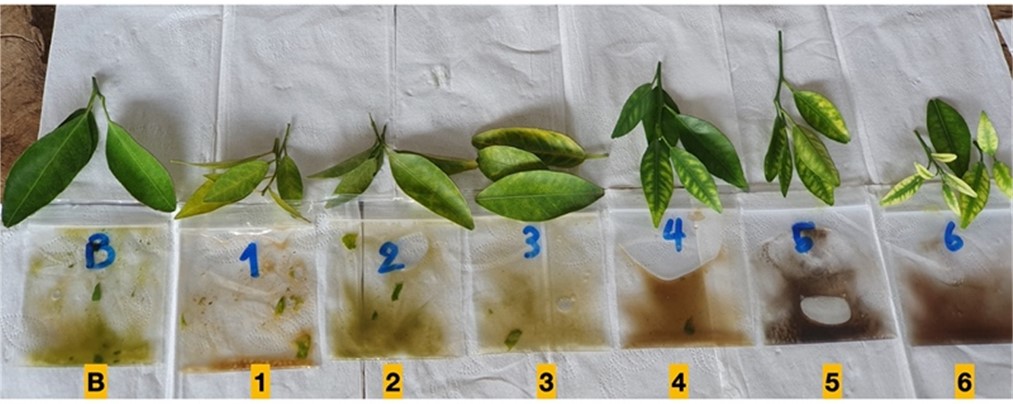
compared to baseline or no symptom (B)
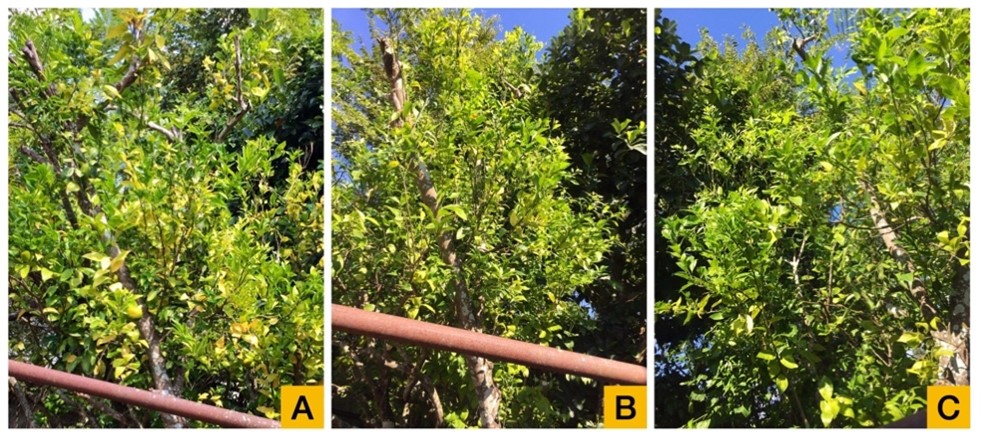
before treatment (A), 10 days after treatment (B), and 25 days after treatment (C)
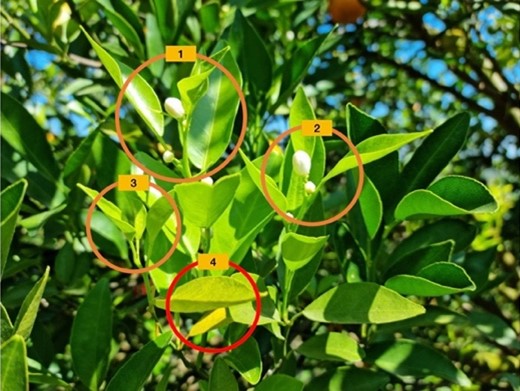
compared to before treatment (4).
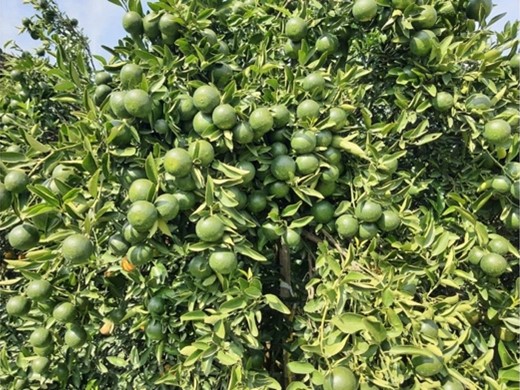
The cost of three treatments, including trunk injections of hybrid solution and ampicillin as well as foliar applications of hybrid solution, was determined as shown in Table 4.14.
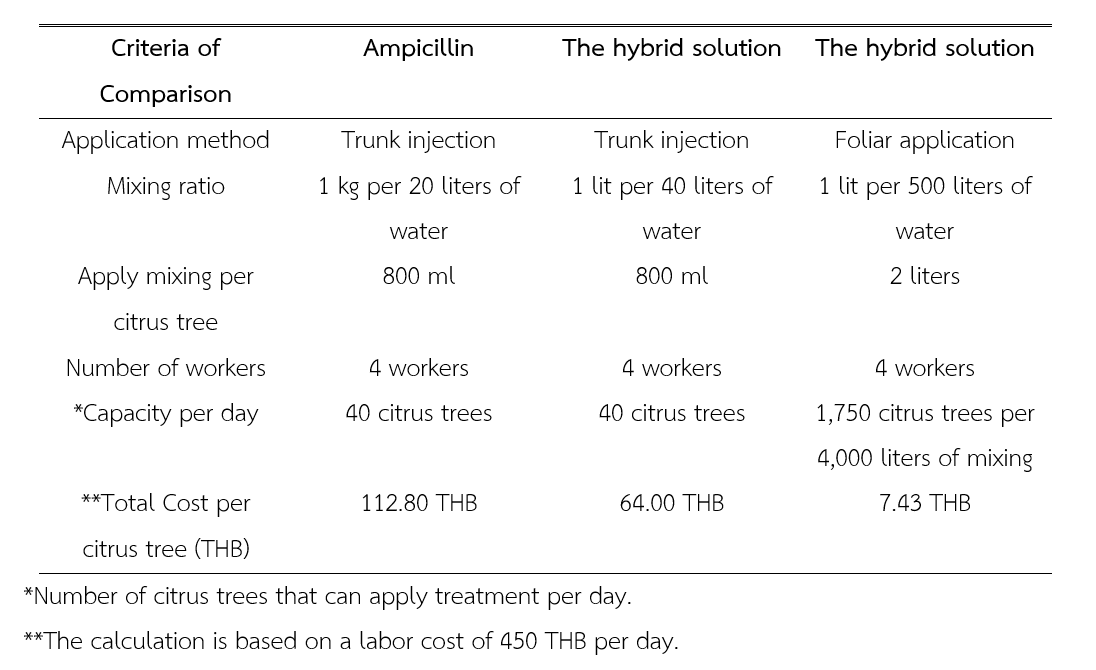
According to cost calculations that considered the number of workers and treatment capacity that could be applied each day, ampicillin cost 112.80 THB, while the application of hybrid solution by trunk injection and foliar spraying cost 64.00 THB and 7.43 THB, respectively.
Based on the percentage of incomplete citrus fruits and the total yield in kilograms, it was determined from the citrus harvest data in this experiment that the ampicillin treatment group’s percentage of incomplete fruits was 25% and the hybrid solution’s percentage was 5% in both the trunk injection and foliar application groups. The results are shown in Table 4.15.

Reference
- Jaikuankaew, S., Paradornuwat, A. & Chowpongpang, S. 2016. Huanglongbing disease of pomelo and antibiotics chemotherapy: case study in Koaw-Tang- Kwao from Chainat province, Thailand. Proceedings of 54th Kasetsart University Annual Conference: Plants, Animals, Veterinary Medicine, Fisheries, Agricultural Extension, and Home Economics. 108-115. Available https://kukrdb.lib.ku.ac.th/proceedings/kucon/search_detail/result/332041
- Jantasorn, A., Paradornuwat, A., Chowpongpang, S., Chunwongse, J. & Thaveechai, N. 2007. Diagnosis of greening disease of Citrus spp. in Thailand. Proceedings of 45th Kasetsart University Annual Conference: Plants, 218-225. The Thailand Research Fund, Bangkok (Thailand). Available https://kukr.lib.ku.ac.th/kukr_es/index.php?/BKN/search_detail/result/10134
- Stephano-Honedo, J.L., Torres-Gutie ́rrez, O., Toledano-Magan ̃, Y., Gradilla-Mart ́ınez, I., Pestryakov, A., Sanchez-Gonza ́lez, A., Garc ́ıa-Ramos, J.C. & Bogdanchikova, N. 2020. ArgovitTM silver nanoparticles to fight Huanglongbing disease in Mexican limes (Citrus aurantifolia Swingle). The Royal Society of Chemistry, 10, 6146–6155.
- Vatcharakajon, P. et al. 2023. Silver nanochito Oligomer hybrid solution for the treatment of citrus greening disease (CGD) and biostimulants in citrus horticulture. Horticulture, 9, 275. https://doi.org/10.3390/horticulturae9060725

